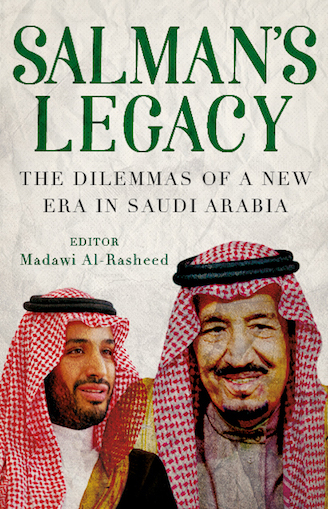by Paul Aarts
It’s not (yet) easy to make sense of the ‘new’ Saudi Arabia. Among the ongoing flurry of commentaries one regularly reads dire headlines such as ‘The House of Saud: The beginning of the end’ and ‘Saudi Arabia: The coming civil war’. Equally, it’s not difficult to find less gloomy and even outright rosy forecasts of the Kingdom’s future under the Salmans. The New York Times’s Thomas Friedman beats the lot by hailing Crown Prince Mohammad bin Salman’s adventurism as ‘Saudi Arabia’s Arab Spring, At Last’. (Though one might argue that Dennis Ross rivals Friedman when calling for ‘America to get behind the revolutionary crown prince’).
Compared to most of Madawi Al-Rasheed’s op-ed pieces (which she writes frequently) this edited volume‘s tone is more sober, navigating between the opposing accounts of breakdown and endurance. She has collected a fine group of scholars (young and old), with different disciplinary backgrounds, covering aspects of Saudi history, contemporary political, economic and social challenges as well as foreign relations. Views vary among the contributors, which indeed – as the book claims – heightens the understanding of the subject.
The book is divided into three sections: ‘State and society’, ‘Saudi Arabia and transnational Salafiyya’, and ‘foreign relations’. Compared to the first two sections, the last one is the least convincing. Though Toby Matthiesen’s chapter on Saudi Arabia and the Cold War offers a wealth of interesting (and hitherto little known) material on an important under-researched topic, one wonders how this helps in getting a grip on present-day developments. Al-Rasheed’s chapter ‘Winning the USA, losing the rest’, an extension of a previous LSE blog series, digs less deep than one would expect on such an important subject. Moreover, it suffers from a certain bias vis-à-vis Iranian foreign policy, i.e. treating Saudi and Iranian interventions in the region as alike (also uncritically repeating notions like ‘the undoubtedly genuine Iranian threat’ and ‘the Iranian-backed Houthis’). Clearly, a separate chapter on Saudi-Iranian relations is missing from the volume. The closing chapter, ‘China’s rise in the Gulf’, authored by Naser al-Tamimi, disappoints by offering a lot of figures but very few new insights. Is his assertion that ‘China’s interest in the Middle East will expand significantly in the future, and so will its role’ not stating the obvious?
The ‘state and society’ section has two excellent contributions (by Al-Rasheed and Steffen Hertog); a brief exposé by Gregory Gause III on the kingdom’s resilience and concomitant challenges; an insightful chapter on the confusion of regional and sectarian identities (by Sultan Alamer); and one rather lengthy chapter on emerging Saudi feminism (by Nora Daoiji). In a novel way, to this reviewer at least, Al-Rasheed convincingly shows why it is meaningful – if not necessary – to take rumours about the House of Saud seriously. Back-fence talk has become crucial to the ‘mystique’ and power of the Saudi monarchy, ‘enhancing conspicuous submission’. This chapter should be required reading for anyone who wants to familiarise themselves with the Al Saud’s multiple strategies of survival.
When it comes to an analysis of present-day austerity policies, seen in a historical perspective, Hertog’s chapter is invaluable. Partly building on his earlier Princes, Brokers, and Bureaucrats (remarkably, adding a correction to his previous insights), he offers a comprehensive and lucid evaluation of the Saudi redistributive economy in times of low(er) oil prices. Noteworthy is the fact that although the kingdom has gone through strong fiscal adjustments since 2015, hurting many Saudi citizens, to date very few opposing voices are heard. A sense of ‘fatalism’ seems to reign, Hertog concludes. Against the backdrop of enormous structural economic problems – with huge (youth) unemployment figures standing out – nobody can say how long this will last, but Hertog may be too deterministic here.
The book’s second section is concerned with different facets of much-discussed Salafism. Andrew Hammond’s delving into its genealogy, the kingdom’s ‘Islamization of foreign policy’ since the 1960s, and – more interestingly – its remarkable use by the Turkish military regime in the 1980s, are stimulating to read. However, as noted above with regard to Matthiesen’s contribution, it’s not immediately clear how all this facilitates our grasping of Salman’s kingdom (let alone the crown prince’s ambition to return to the times of ‘moderate Islam’).
Readers who don’t have time to read Michael Farquhar’s excellent monograph Circuits of Faith (2017) are strongly advised to read his chapter in this edited volume. It’s a short and cogent summary of his view that there is no such thing as a ‘universal Muslim umma’ or Salafism as a transnational ‘movement’. The interaction of the ‘universal’ with local and national attachments should get more attention, Farquhar decisively contends, using the much-disputed Islamic University of Medina’s reputation as a case study.
Much (including hyperbolic statements) has been said about the affinity between Wahhabism and the Islamic State. Cole Bunzel adds to this debate by pointing out the theological connections between Turki al-Bin’ali, a prominent IS ideologue, and the notorious Saudi scholar ‘Abdullah bin Jibrin. Insightful, yes, but Bunzel moves on thin ice when stating that after having adopted a decidedly Wahhabi posture, the ‘potential for [IS] jihadi unrest in Saudi Arabia continues to loom large’. Does it? Nadav Savran finally does not so much refer to Wahhabism, but concentrates on the opaque world of kinship and tribal politics when dealing with the chilling phenomenon of parricide that has accompanied suicide bombings.
In the past fifty to sixty years, forecasting political paralysis was a safe bet for those who practice Saudology; not any more. Further surprises are to be expected. Al-Rasheed’s volume helps us to be better prepared for Saudi unpredictability.
 Paul Aarts has been a senior lecturer in International Relations at the University of Amsterdam for more than thirty years. His most recent book (written with Carolien Roelants) is Saudi Arabia: A Kingdom in Peril (Hurst 2016) which has been translated into Dutch, Arabic and Persian. He tweets at @PaulAarts2
Paul Aarts has been a senior lecturer in International Relations at the University of Amsterdam for more than thirty years. His most recent book (written with Carolien Roelants) is Saudi Arabia: A Kingdom in Peril (Hurst 2016) which has been translated into Dutch, Arabic and Persian. He tweets at @PaulAarts2







